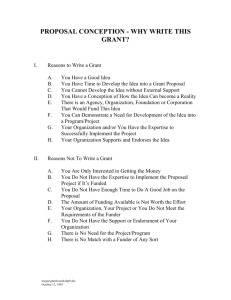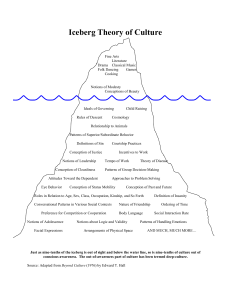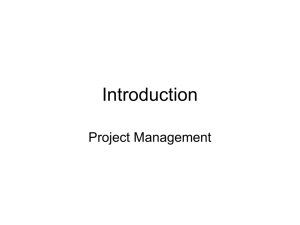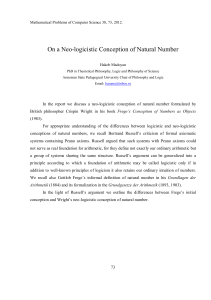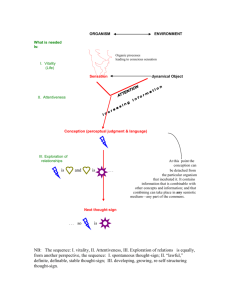USING GRAPHICAL PROFILES TO STUDY THE LEARNING AND TEACHING OF MATHEMATICS
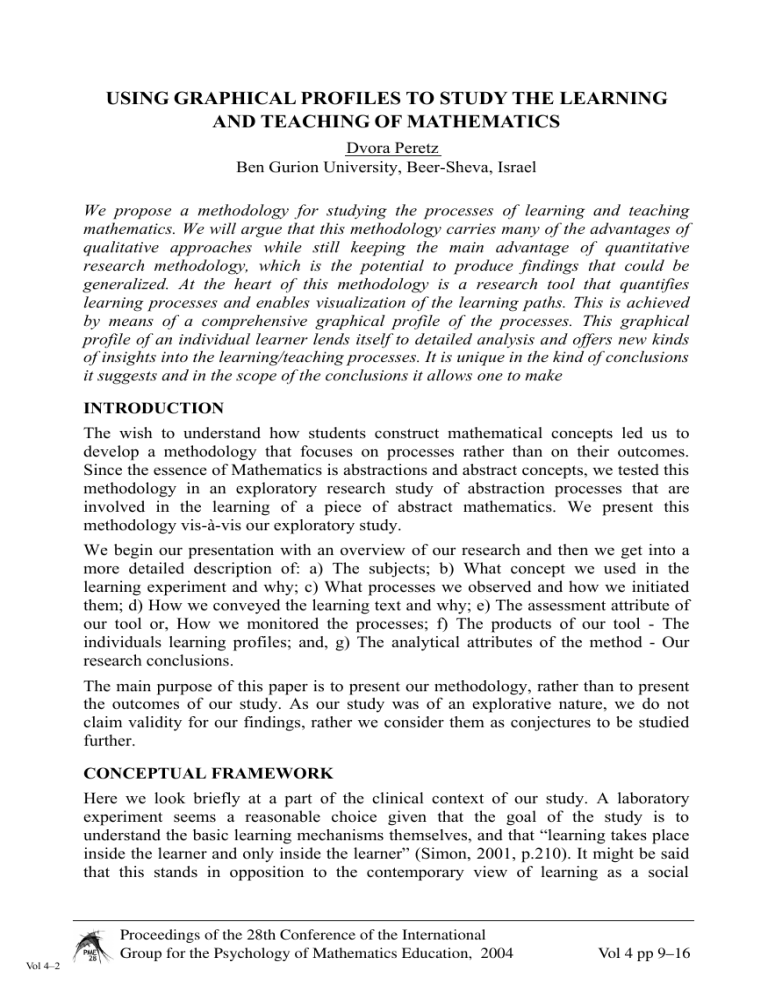
Vol 4–2
USING GRAPHICAL PROFILES TO STUDY THE LEARNING
AND TEACHING OF MATHEMATICS
Dvora Peretz
Ben Gurion University, Beer-Sheva, Israel
We propose a methodology for studying the processes of learning and teaching mathematics. We will argue that this methodology carries many of the advantages of qualitative approaches while still keeping the main advantage of quantitative research methodology, which is the potential to produce findings that could be generalized. At the heart of this methodology is a research tool that quantifies learning processes and enables visualization of the learning paths. This is achieved by means of a comprehensive graphical profile of the processes. This graphical profile of an individual learner lends itself to detailed analysis and offers new kinds of insights into the learning/teaching processes. It is unique in the kind of conclusions it suggests and in the scope of the conclusions it allows one to make
INTRODUCTION
The wish to understand how students construct mathematical concepts led us to develop a methodology that focuses on processes rather than on their outcomes.
Since the essence of Mathematics is abstractions and abstract concepts, we tested this methodology in an exploratory research study of abstraction processes that are involved in the learning of a piece of abstract mathematics. We present this methodology vis-à-vis our exploratory study.
We begin our presentation with an overview of our research and then we get into a more detailed description of: a) The subjects; b) What concept we used in the learning experiment and why; c) What processes we observed and how we initiated them; d) How we conveyed the learning text and why; e) The assessment attribute of our tool or, How we monitored the processes; f) The products of our tool - The individuals learning profiles; and, g) The analytical attributes of the method - Our research conclusions.
The main purpose of this paper is to present our methodology, rather than to present the outcomes of our study. As our study was of an explorative nature, we do not claim validity for our findings, rather we consider them as conjectures to be studied further.
CONCEPTUAL FRAMEWORK
Here we look briefly at a part of the clinical context of our study. A laboratory experiment seems a reasonable choice given that the goal of the study is to understand the basic learning mechanisms themselves, and that “learning takes place inside the learner and only inside the learner” (Simon, 2001, p.210). It might be said that this stands in opposition to the contemporary view of learning as a social
Proceedings of the 28th Conference of the International
Group for the Psychology of Mathematics Education, 2004 Vol 4 pp 9–16
process; however, Simon’s (2001) perspective of the social aspect of learning suggests otherwise: “…‘Social’ means more than ‘having people around’. … Perhaps the most important social influence on learning are … forms of written communication ... Putting learning in books does not desocialize it.”(p. 207).
Elaborating on this line of thought, we assert that laboratories do indeed incorporate the social values and beliefs of the ‘social construct’ that built it. Thus, conducting research on learning in a lab environment does not in itself oppose the current social trend in the educational milieu; rather, it offers another level of observation.
Some might argue that from a pedagogical point of view, a 'clinical' context for a learning experiment is not appropriate, as their main interest is in learning as a social activity (usually in a classroom context). Atkinson et al (2000, p.185), however, argue for the transferability of lab experiments to the classroom context and are strongly in favor of labs as a context of research on learning.
One-way to partly control the effect of the teaching method on the learning process is to present the concepts to be learned only by examples of the concept. Atkinson at al
(2000) present a comprehensive literature review of the Learning-From-Examples
(LFE) research paradigm. They refer to learning from ‘worked’ examples, which provide an expert problem-solving model for the learner to study and emulate
(p.181). In most research on problem-solving, the LFE serves as the focus or as the target of the research, and not as its context. This kind of research aims at gaining insight into the LFE as a (preferred) mode of teaching or of learning, and the subject matter serves as the context. However, researchers of concepts-formations (1950-
1970) used LFE in their experiments in a different way; they used examples as instances of a concept. Atkinson et al (2000) put it thus: “A typical study … measured students’ ability to identify a member of a target concept after viewing numerous instances and non-instances of it, to … derive the underlying concept common to the examples”. (p.182). In concept-formation research the LFE paradigm serves only as a tool to convey the concept to be learned. As such, the LFE is part of the context of the research, rather than its focus.
OVERVIEW OF THE RESEARCH
We closely observed two abstraction processes that we had identified theoretically:
Abstraction Process (AP) and Reversed Abstraction Process (RAP). For the purposes of this paper we define the two learning processes by the mode of their instigation.
One is instigated by learning from a text which is presented in an order of increasing abstractness level (AP - group U in the experiment – ten ninth-grade subjects), while the other is instigated by learning from a text which is presented in an order of decreasing abstractness level (RAP - Group D in the experiment - ten ninth-grade subjects). Computerized learning modules presented the learning texts, which were identical in both modules except for the order in which the chapters appeared in each of them.
The subjects were twenty ‘regular’ students in an Israeli suburban high school, in the
4–10 PME28 – 2004
last month of their ninth grade school year. They were all volunteers and joined the experiment on a first come basis. There was no randomizing in the procedure of assigning the volunteers to one of the two groups of subjects, U and D. The experiment took place at school, in a room especially assigned for the experiment.
We took each of the subjects out of class for an individual learning session of approximately three hours.
The module kept track of all the time periods that the subjects spent at each point
(assignment) as well as of their answers. At the same time, it created a personal file for each of the subjects, which was later used to assess the learning process of the individual. Moreover, the module enabled the researcher to assess each of the answers (to about 204 short questions), according to approximately forty different indices. Subsequently, the module created a file of numerical vectors for each subject as a product of the evaluation stage, where each of the vectors represented the progression of the learning process according to one of the indices. These vectors were readable by the computer algebra system, Mathematica , which we used for constructing a graphical profile for each subject. The final analysis of the findings of our experiment was based primarily on these graphical profiles.
THE RESEARCH METHODOLOGY
Students were given the Mathematical Relation (MR) concept to learn because it is both highly abstract and difficult to learn. This corresponds with Bereiter’s (1990) recommendation to use difficult concepts in order to explore learning processes. The
MR generalizes many of the concepts that students learn in school: intuitive relations, functions, linear transformations, mathematical operations, etc. The learning of the
MR concept in the experiment enabled us to investigate the abstraction capabilities of the participants as they tried to relate the new MR concept to more basic concepts they already knew. Since our main goal was to concentrate on a thorough, in-depth analysis of a short learning episode, we limited the learning to the definition 1 of the
MR concept. However, in order to avoid having to teach the students such concepts as the Cartesian product of two sets, sub-sets etc., we used a simplified version 2 the formal mathematical definition of the MR.
of
Since our interest lies in the learning processes of individuals, we strove to limit the impact of the teacher and of other external factors on the learning process.
Consequently, we used a computerized learning module to convey the learning text to the participants. We presented the concept using examples, rather than explanations, and presented these examples in a ‘neat’, ‘facts-only’ format without any elaboration.
This was followed by fixed repeated reasoning assignments to force the learner to
‘think aloud’.
1 R is a MR from a set A to a set B if R is subset of the Cartesian product AxB.
2 R is a MR from a set A to a set B if R is a set of ordered pairs of the form (a,b) where a is
an element of A and b is an element of B.
PME28 – 2004 4–11
Basically, our research tool was a computerized module with four functions: instigating (a learning module); monitoring (interactive features); quantifying
(assessment features) and externalizing (graphical profiling) the target processes.
The Learning Module .
In this paper we use the structure of the text as an operational definition for the processes studied. Hence, the learning process initiated by a text that presents the subject to be learned in an order of increasing abstractness will be referred to as an Abstraction Process (AP), while the ‘inverse’ process that is initiated by a text that presents the learning subject in an order of decreasing abstractness will be referred to as a Reversed Abstraction Process (RAP) 3 . The abstractness level of a specific example of the MR was determined by an abstractness scale we devised according to the mathematical abstractness level of its different components and its different characteristics in widening circles of mathematical abstraction (see also
Mitchelmore & White, 1995).
Our learning modules presented fifteen levels of abstraction, which we theoretically defined before the experiment. However, in our final analysis we referred only to three main levels (low, intermediate and high level of abstractness) and each of these levels was again divided into two sub-levels (low and high).
Each of the fifteen chapters contained positive and negative examples of MR, all of approximately the same level of abstractness. In the bottom-up module (group U -
AP) the chapters are presented in an order of increasing abstractness and in the topdown module (group D – RAP) they are in an order of decreasing abstractness. It is worth noting that the two modules are identical except for the order in which the chapters appear.
The Monitoring Device . When designing the assignments we aimed towards a maximal exposure of the participants' thoughts. Thus, following each of the examples, the module presented several kinds of assignments: a) Reasoning assignments; b) Construction of examples assignments; c) Counting elements assignments; and d) Identification assignments. At the end of each of the fifteen chapters the learners were asked to: (a) Describe their feelings, (b) Define a MR verbally, and (c) Construct an example of a MR.
The Assessment Device . Assessment of the learning processes was performed by means of thirty-nine indices that were designed to evaluate and record the progression of the conception of ten different aspects of the MR and of the three general aspects of the learning process (time, affective and fixation aspects). These indices were used to evaluate and grade the efforts of individual subjects in each point (point=assignment, 204 points in total) of the learning process in an accumulated manner, and were normalized to values between –1 and +1 for purposes
3 Though interesting, yet, the theoretical attributes and significance of the AP and the RAP as abstraction processes lie outside of the scope of this paper and therefore will not be discuss it here
4–12 PME28 – 2004
of comparison. To illustrate: if the value of the positive index that measured the conception of the Set aspect of the MR had an accumulated value of 0.5 by a certain point, this would mean that by this point the student had gained half of what we considered to be the ‘full’ positive conception (understanding) of the MR as a Set.
The assessment was done manually according to the different scales and was then typed up. For the most part, there were three indices associated with each of the aspects. One measured only the progression in a positive direction (i.e. mathematically correct statements and doings, or positive feelings), the second measured only the progression in a negative direction (i.e. mathematically incorrect statements or doings and negative feelings). The third measured the total progression of the conception of the specific aspect – i.e. the sum of both the positive and the negative indices. The fixation aspect of the learning process was assessed only by a negative index, while the time aspect was assessed by two indices, both positive. One measured the time spent at each point and the other measured the elapsed time from the beginning of the learning process to a specific point. Three summation indices, positive, negative and total, assessed the participants’ total positive, total negative and total conception of the MR concept.
The grading at each point was done in a positive manner; i.e. grades were assigned only to the participants’ statements. There was no negative grading for a missing statement, or erroneous statements. To illustrate, if a participant neglected to write
‘ordered pairs’ in his answer regarding an example of MR, it was not documented in either the negative or positive indices. On the other hand, if he did have pairs in his example, but with curly parentheses rather than round, it was documented in both the positive and the negative indices. The positive index was scored for the kind of elements (i.e. pairs) and for the existence of parentheses, but not for their shape. At the same time, the negative index was scored for the shape of the parentheses.
The grading was done in an accumulated manner; in the above example, a new occurrence of an ordered pair with round parentheses would change the grading of the negative index that assessed the conception of the kind-of-elements aspect by taking away the points that were assigned previously to the wrong shape of parentheses, and at the same time the positive index would be scored for the correct shape of parentheses.
Graphical Profiling .
The progression of the indices’ values was graphed on three axes: the Process Progression Axis - Point x on this axis marked the x th assignment to be handled (one of 204); the Location Axis - shows the location of the point in the bottom-up module; the Time Axis - shows the elapsed time from the start. Note that a specific point on each of the axes has a different history with regards to the two observed processes. The graphs were processed by the Computer Algebra
Mathematica , based on a file of numerical vectors (204- dimensional) that the modules produced for each of the individual subjects.
The learning processes of each of the twenty individual subjects, ten in each group, U
PME28 – 2004 4–13
and D, were presented as an individual profile consisting of approximately sixty graphs (most of them continuous; few discrete) and a non-graphic set of data. The
‘average process’ of each of the two groups of learner was also presented via such a profile.
RESEARCH CONCLUSIONS
We derived dozens of ‘local’ conclusions about the conception of each of the ten aspects of the MR and about each of the three general aspects of the learning (time, affective and fixation), as well as more ‘global’ conclusions about the whole conception process. There were also conclusions concerning the effects of examples of a specific level of abstraction on the learning process.
In the following graphs the dotted line represents the process in group D - the RAP, while the continuous line represents the process in group U – the AP. The vertical lines represent the different chapters (each chapter presents examples of different levels of abstractness) of the bottom-up module. In total the x-axis shows 204 points; each represents a short assignment. The y-axis represents the measure of effectiveness.
Figure 1 Conception of the set aspect Figure 2 Total conception
Figure 1 shows the average progression of the positive conception of the Set aspect of the MR concept in both groups of student, U and D. We can see that the average achievements of the students in group D were slightly higher than those in group U at the end of the learning process, even though along most of the learning process axis, group U students did better. This is seen also in the progression of the total conception of the Set aspect. This demonstrates the accumulative dominancy of the one process over the other, and leads to the conclusion that The RAP is more dominant than the AP in respect to the conception of the Set aspect of the MR.
Figure 2 shows the progression of the total conception of the MR concept in both groups of student. We can clearly see that along the learning process axis, the achievements of the students in group U (bottom-up), were higher than those in group
D (taking into account the negative conception as well). This leads to the conclusion that the AP is more effective in respect to the total conception (positive minus the negative) of the MR concept . This is effectiveness in the sense that at any given moment in the learning process, the students in group U gained a greater part of what was considered to be the full conception of the MR concept.
Figure 3 presents the progression of the average negative conception of the Size
4–14 PME28 – 2004
aspect of MR in both groups of learners, U and
D. Here we can clearly see that the graph of group D (top-down) is higher than the graph of group U. This leads to the conclusion that on
Figure 3 Negative conception average, students in group D made fewer errors.
This in turn implies that the RAP is better at leading the conception towards the positive direction . We find it intriguing that this is seen in the graphs that depict the progression of the conception of most of the aspects of the MR, as well as in the one depicting the total conception of the MR concept.
Figure 4 The Affective aspect Figure 5 The Time aspect
Figures 4 and 5 present the progression of the Affective and the Time aspects of the learning process in both groups. From here we can see that there are no significant differences between the two processes, AP and RAP, in respect to the Elapsed Time aspect nor in respect to the Affective aspect of the learning process . This is especially interesting in light of the prevalent view that considers the deductive approach among the causes of affective and cognitive difficulties in learning mathematics.
DISCUSSION
We argue that our (almost) continuous probing does indeed offer an outline of the progression of learning processes. We do, however, make a cautious comment regarding the sensitivity of the scales we used to assess each aspect of the monitored process, at each point. As we see it from our exploratory study, the scales are the weakest link. We nevertheless believe that continual studies, on larger and less biased samples, will eventually yield an accurate depiction of learning processes.
Our study encompasses other weaknesses too: it focuses on a very short learning episode (about three hours), while meaningful learning could take much longer (even years). It monitors the conception of a very small ‘piece’ of a whole concept (MRs could be the subject of years of study) and ‘flattens’ the complex research setting
(putting a rich learning process into a graphical profile, even if it does contain dozens of graphs); it ‘extrapolates’ without sufficient justification (when stretching a line between the conception in two adjacent points to achieve the continuousness of the process); and it also attempts to derive general conclusions based on a non-statistical sample (small and non-random).
But at the same time, the short learning episode allows us to concentrate on deep and detailed observation, and the ‘flat’ graphical portrayal enables us to conduct a precise
PME28 – 2004 4–15
analysis of the findings. While the design of the modules could have affected the processes that we observed, they also facilitated a close monitoring of the learning process. And lastly, the simultaneous nature of the tool that allowed us to observe the process from as many angles as we desired and had the resources for, gives this kind of research enormous potential.
One of the concerns that prompted the qualitative reform was the segmented nature of research on learning up until this point. Qualitative scholars argue quite rightly that one needs to see the ‘whole’ learner, which for some includes also the learner’s social envelope, in order to study complex learning processes. The tools that qualitative scholars advocate are indeed comprehensive and thorough. Yet at the same time they fail to make irrefutable general claims about their research findings (Schoenfeld,
1999). The question is: do we have anything to gain by quantifying a qualitative situation? We believe that we do. Moreover, we believe that our methodology, while not qualitative, does indeed encompass the essence of qualitative methodologies. We believe it offers a holistic, comprehensive and thorough description of the learner - all of which are considered qualitative qualities and yet, at the same, also offers the means to make irrefutable general claims about the learning process.
The method we used, in which we probed every minute or so, may be compared to the kinds of observation made by qualitative researchers when they closely observe a subject. The kinds of question that the learners answered in our research are in many ways similar to those asked by qualitative researchers. Taking into account simultaneously all the aspects involved in the learning situation is in fact a kind of holistic approach. The methodology used could also monitor the physical aspects of learning (by incorporating medical devices), the social aspects (by video recording), and the motivational aspects (by incorporating psychological tools). Moreover, if one argues that the absence of the human perspective might affect the description, we can suggest numerous ways in which that perspective might be incorporated as a further monitoring device.
References
Atkinson, R.K., Derry, S.J., Remkl, A., and Wortham, D.W. (2000). Learning from
Examples: Instructional Principles from the Worked Examples Research, Review of
Educational Research , 70 (2), 181-214.
Bereiter, C. (1990). Aspects of an Educational Learning Theory, Review of Educational
Research , 60(4), 603-624.
Mitchelmore, M.C. and White, P. (1995). Abstraction in Mathematics: Conflict, Resolution and Application, Mathematics Education Research Journal, 7(1), 50-68.
Schoenfeld, A.H. (1999). Looking Toward the 21st Century: Challenges of Educational
Theory and Practice, Educational Researcher , 28 (7), 4-14.
Simon, H.A. (2001). Learning to Research about Learning, in S.M Carver and D. Klahr
(eds), Cognition and Instruction , Twenty-Five Years of Progress. Lawrence Erlbaum
Ass., Mahwah, New Jersey, London.
4–16 PME28 – 2004
